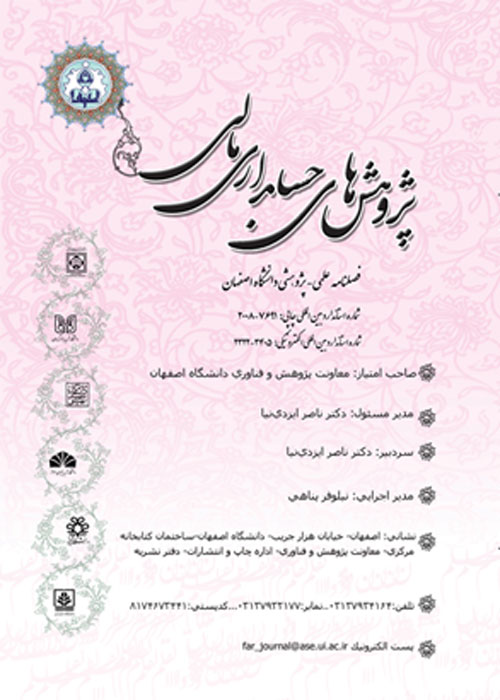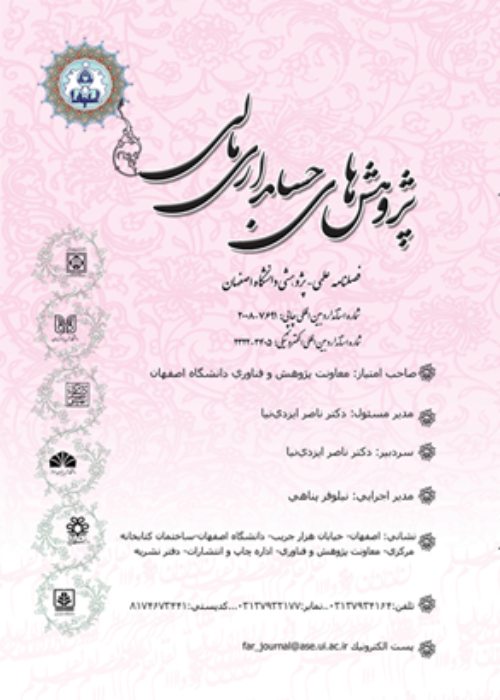فهرست مطالب

فصلنامه پژوهش های حسابداری مالی
سال دهم شماره 1 (پیاپی 35، بهار 1397)
- تاریخ انتشار: 1397/02/31
- تعداد عناوین: 6
-
-
صفحات 1-18چرخه عمر از مهم ترین عواملی است که ویژگی های رفتاری شرکت را تعیین می کند و بر ساختار منابع، قابلیت ها و توانمندی های آن اثرگذار است. در این پژوهش، رفتار ریسک پذیر طی چرخه عمر شرکت و رابطه این رفتار با عملکرد مالی آتی بررسی شد. به این منظور، رفتار ریسک پذیر با استفاده از نوسان های تعدیل شده نرخ بازده دارایی ها بر حسب صنعت، چرخه عمر با توجه به الگوی جریان های نقدی شرکت در طبقات عملیاتی، سرمایه گذاری و تامین مالی و عمکرد مالی از طریق نرخ بازده دارایی ها سنجیده شد. در این راستا، داده های 150 شرکت در بازه زمانی 1387 تا 1394 (1200 شرکت- سال) با در نظر گرفتن برخی ویژگی ها آزمون شد. برای تجزیه و تحلیل داده ها از روش گشتاورهای تعمیم یافته استفاده شد تا رفتار پویای متغیر ریسک پذیری مدنظر قرار داده شود. نتایج نشان داد شرکت ها در مراحل ظهور و افول ریسک بیشتری را در مقایسه با مرحله بلوغ می پذیرند. به علاوه، رفتار ریسک پذیر شرکت هایی که در مراحل ظهور و افول قرار دارند، عملکرد مالی ضعیف تری را در مقایسه با شرکت های فعال در مراحل رشد و بلوغ در دوره مالی بعد به همراه دارد.کلیدواژگان: رفتار ریسک پذیر، چرخه عمر شرکت، عملکرد مالی
-
صفحات 19-36درسال های اخیر، در ادبیات مالی، توجه زیادی به سطح نگهداشت وجه نقد شرکت ها شده است. این علاقه و توجه، ناشی از این واقعیت است که شرکت ها، مقادیر با اهمیتی از وجه نقد را در ترازنامه خود گزارش می کنند. مسئولیت اجتماعی شرکت از مهم ترین عوامل موثر در عملکرد مالی و اجتماعی آن است و نقش اصلی را در واکنش های سرمایه گذاران نسبت به شرکت ایفا می کند. هدف اصلی پژوهش حاضر، سنجش مسئولیت اجتماعی شرکت ها و تاثیرگذاری آن بر نگهداشت وجه نقد از طریق شاخص ریسک نظام مند، ریسک غیر نظام مند و حاکمیت شرکتی است. برای آزمون فرضیه ها، نمونه ای شامل 91 شرکت از شرکت های پذیرفته شده بورس اوراق بهادار تهران در سال های 1387تا 1394 انتخاب شده اند. روش مورد استفاده به منظور آزمون فرضیه ها، روش تخمین سیستم معادلات هم زمان از طریق الگوی حداقل مربعات سه مرحله ای (3SLS) است. نتایج پژوهش نشان می دهد مسئولیت اجتماعی از طریق ریسک غیرنظام مند بر نگهداشت وجه نقد تاثیر معنادار و مثبتی دارد. همچنین، مسئولیت اجتماعی از طریق ریسک نظام مند بر نگهداشت وجه نقد تاثیر معنادار و منفی دارد. نتایج نشان می دهد مسئولیت اجتماعی از طریق حاکمیت شرکتی بر نگهداشت وجه نقد تاثیر معنادار و مثبتی دارد.کلیدواژگان: مسئولیت اجتماعی شرکت، نگهداشت وجه نقد، ریسک غیرسیستماتیک، ریسک سیستماتیک، حاکمیت شرکتی
-
صفحات 37-54با وجود افزایش سازوکارهای نظارتی بر مدیریت سود، مدیران برای تامین انتظارات تحلیلگران و سرمایه گذاران از سود، انگیزه دارند. از سوی دیگر، ناآگاهی افراد برون سازمانی نسبت به شیوه های مدیریت انتظارات، برخلاف آگاهی نسبت به روش های مدیریت سود، موجب ترغیب مدیریت به کاهش سطح انتظارات به جای افزایش میزان سود می شود. از آنجا که افزایش میزان و تعداد تجدیدنظرها در انتظارات تحلیلگران و سرمایه گذاران، واکنش منفی بازار را به همراه دارد، پیش بینی می شود حضور متخصصان حسابداری و مالی در کمیته حسابرسی منجر به کاهش این تجدیدنظرها شود. در این پژوهش، به بررسی رابطه تخصص حسابداری و مالی در کمیته حسابرسی با مدیریت انتظارات پرداخته شده است. بدین منظور، نمونه ای از 112 شرکت پذیرفته شده در بورس اوراق بهادار تهران، طی سال های 1391 تا 1395 انتخاب شد. نتایج آزمون فرضیه ها نشان داد حضور اعضای متخصص در کمیته حسابرسی، بر احتمال رخداد مدیریت انتظارات و ایجاد اختلاف سود نامنفی حاصل از آن تاثیر نمی گذارد؛ اما میزان مدیریت انتظارات کاهش می یابد.کلیدواژگان: مدیریت انتظارات، تخصص کمیته حسابرسی، اختلاف سود نامنفی
-
صفحات 55-74پژوهش حاضر با لحاظ کردن امکان تغییر دارایی ها، تاثیر «انحراف از اهرم هدف» و «کسری/ مازاد مالی» بر رفتار شرکت ها در تعدیل اهرم را بررسی کرده است. پژوهش های اخیر نشان داد مقدار اهرم، فارغ از سیاست های تامین مالی، به میانگین گرایش دارد. این پدیده که بازگشت مکانیکی به میانگین نامیده می شود، بر سرعت تعدیل محاسبه شده تاثیر می گذارد. این پژوهش به بررسی اثر پدیده بازگشت به میانگین اهرم، بر سرعت تعدیل نیز پرداخته است. بدین منظور نمونه ای مشتمل بر 155 شرکت پذیرفته شده در بورس اوراق بهادار تهران طی سال های 1384 تا 1394 بررسی شد. برای بررسی اثر «جهت انحراف از اهرم هدف» و «کسری/ مازاد مالی» بر سرعت تعدیل از روش رگرسیون حداقل مربعات تعمیم یافته و برای بررسی اثر پدیده بازگشت اهرم به میانگین از روش بوت استرپ استفاده شده است. نتایج به دست آمده نشان داد شرکت هایی که در بالای اهرم هدف قرار داشته اند و با کسری مالی روبه رو بوده اند، نسبت به سایر شرکت ها با سرعت بیشتری ساختار سرمایه خود را تعدیل کرده اند. همچنین، با حذف اثر بازگشت به میانگین، سرعت تعدیل اهرم کاهش یافت.کلیدواژگان: بازگشت مکانیکی به میانگین، سرعت تعدیل اهرم، جهت انحراف از اهرم هدف، کسری- مازاد مالی
-
صفحات 75-94ارزیابی عملکرد شرکت ها، مسئله سهام داران فعلی و بالقوه است. بنابراین، پژوهش حاضر، به تبیین مدلی برای ارزیابی عملکرد شرکت های سرمایه گذاری با استفاده از روش تحلیل پوششی داده ها پرداخته است به نحوی که به وسیله PCA، وابستگی متغیرهای ورودی و خروجی با تجزیه به عامل های اصلی از بین برده شود. سوال اصلی در این تحقیق به این صورت مطرح است که چگونه می توان عملکرد شرکت های سرمایه گذاری را ارزیابی کرد؟ به منظور پاسخگویی به این سوال، کلیه شرکت های سرمایه گذاری پذیرفته شده در بورس ایران انتخاب شده اند و آخرین گزارشهای سالانه موجود شرکت های سرمایه گذاری در سال 1395 مورد تحلیل قرار گرفته است. برای طراحی الگوریتم پیشنهادی، از رویکرد تلفیقی DEA-PCA استفاده شد که نهایتا منجر به طراحی مدل ارزیابی عملکرد گردید. نتایج حاصل از اجرای الگوریتم پیشنهادی نشان می دهد که از مجموع 34 شرکت سرمایه گذاری تحت بررسی در سال 1395، فقط 4 شرکت با امتیاز کارایی یک، کارا می باشند. به عبارت دیگر 12درصد شرکت های سرمایه گذاری کارا و 88 درصد ناکارا می باشند که البته شرکت های کارا به عنوان الگو برای سایر شرکت ها می باشند.کلیدواژگان: تحلیل پوششی داده ها، تجزیه به مولفه های اصلی، ارزیابی عملکرد، شرکت های سرمایه گذاری
-
Pages 1-18Risk taking behavior over firm's life cycle and its relationship with financial performance are examined in this research. Life cycle is one of the most important factors which determines properties of firm's behavior and affect its resource structure, empowerments and abilities. So an adjusted version of ROA with regard to industry effect is used to measure risk taking behavior; the pattern of cash flow in each category including operating, investing and financing and ROA proxy are considered to define life cycle and financial performance respectively. As a consequence, financial data for 150 firms during 2008 to 2015 with some considerations is collected. In order to include dynamic behavior of risk taking, generalized method of moments (GMM) is run to analyze data. The results reveal that firms show riskier behavior in introduction and decline phases in comparison with maturity phase. In addition, firms which are in introductory and decline phases operate much weaker than others from financial aspect.Keywords: Risk taking behavior, Firm's life cycle, financial performance
-
Pages 19-36In recent years, there is a lot of attention to keep the cash in companies in financial literatures. This interest has come up from this reality that companies have reported significant amounts of cash in their balance sheet. Companys social responsibility is one of the most effective factors in social and financial operation and plays a key role in investors reactions to a company. The main purpose of the present study is to evaluate the social responsibility of companies and their effects on keeping cash through systematic risk index and non-systematic risk and corporate sovereignty. To test the hypothesis, a sample of 91 companies from the accepted ones is Tehran securities exchange was choosen in 2009to 2016. The appropriate method to test the hypothesis is to assess the synchronous equation system through (3SLS) minimum three level has squares. The results show that social responsibility through idiosyncratic risk is a significant and positive impact on cash holdings. As well as social responsibility through systematic risk has a significant negative impact on its cash holdings. The results show social responsibility through corporate governance has positive significant effect on its cash holdings.Keywords: Corporate Social Responsibility, Cash Holding, Idiosyncratic Risk, systematic Risk, Corporate governance
-
Pages 37-54Despite increasing the governance mechanisms of earnings management, the managers have incentives to meet investors and analystsexpectations of the earnings. On the other hand, the existence of outsiders that uninformed to methods of expectations management, unlike to methods of earnings management, leads to encourage the manager to reduce the level of the expectations, instead of increasing the level of the earnings. Since the increase in the magnitude and incidence of revisions in the investors and analystsexpectations leads to negative market reaction, it is expected that the existence of finance and accounting expertise on audit committees leads to reduce these revisions. In this paper, it has investigated the association between finance and accounting expertise on audit committees with the expectations management. The sample is consisted of 112 companies listed in the Tehran Stock Exchange for fiscal years 2012 through 2017. The results of testing the hypotheses showed that in the presence of the expert members on the audit committee, did not reduce the likelihood of incidence of the expectations management and incidence of the nonnegative earnings surprises through that but it reduced the magnitude of expectations managementKeywords: Expectations Management, ?? ?Expertise of the Audit Committee, Nonnegative Earnings ?Surprises
-
Pages 55-74This research has investigated the effect of deviation from target leverage and financial deficit/surplus on the corporate behavior in leverage adjustment by considering the possibility of changing assets. Recent studies have shown that leverage, regardless of financing policies, tends to mean. This phenomenon which is called mechanical mean-reversion affects the calculated speed of adjustment. This study examines the effect of leverage mean-reversion on leverage adjustment speed. A sample composed of 155 firms listed in Tehran Stock Exchange (TSE) investigated for years 1384 to 1394. Generalized method of moment regression is used to examine the effect of deviation from target leverage and financial deficit/ surplus on speed of adjustment and bootstrap method is applied for determining the effect of leverage mean reversion. Our results show that firms that are at the top of target leverage and face financial deficit are more likely to adjust their capital structure compared to other companies. The results also show that eliminating the effect of mean-reversion of leverage reduce the leverage adjustment speed.Keywords: Mechanical Mean-Reversion, Leverage Speed of Adjustment, Direction of Target Leverage ?Deviation, Financial Deficit- Surplus
-
Pages 75-94The corporate performance assessment is a matter for current and potential stockholders. Therefore, the present study aims at explicating a model for performance evaluation of investment companies using the data envelopment analysis method, so that by applying PCA, the dependence between input and output variables is eliminated by decomposing to the main factors. The main question in this study is how to evaluate the performance of investment firms? In order to answer this question, all investment companies accepted in the Iranian stock exchange have been selected and the latest available annual reports of investment companies in year 2016, have been analyzed. To design the proposed algorithm, a DEA-PCA compilation approach was used which ultimately led to the design of a performance evaluation model. The results of the proposed algorithm show that out of 34 investment companies under review in 2016, only 4 companies with a performance score of one, are considered as efficient. In other words, 12% of investment companies are efficient and 88% are inefficient, which, of course, efficient companies are patternmakers for other companiesKeywords: Data Envelopment Analysis, Principal Component Segregation, Performance Assessment, ?Investment Companies


